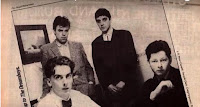 |
| Alistair Hay |
Alistair Hay grew up in the Irish seaside town of Creeslough, located in North West Donegal in Ireland. His father ran the family farm. His father was quite a craftsman and made whateve was needed by the family or at the farm. His father eventually took a job with an engineering firm as a designer and moved the family to East Donegal.
 |
| East Donegal Today |
As Alistair grew up, he went to work with at his fathers business where he learned about composites and fiberglass. This peaked Alistair’s interest in engineer and designing products made of composite materials.
 |
| Royal & Prior - Athlone Tech |
 |
| Seebold Sports Formula One Racing |
He encouraged him to follow his own path and find a career based on what he knew and enjoyed. Hay chose to work with carbon fiber; a subject of which he has amassed tremendous knowledge.
 |
| Steve Vai with Custom Emerald Ultra |
He learned to build guitars by reverse engineering his own guitar. He made many mistakes during his learning curve. He developed a friendship with a skilled luthier that offered him instructions that became a tremendous help.
 |
| The First Emerald Guitar to leave the factory |
During those early years, Emerald Guitars had partnered with Parker Guitars in a deal to use their fret boards. This was a great partnership until Ken Parker and his partner sold Parker Guitars to the musical instrument conglomerate US Music.
 |
| Richie Sambora with Emerald |
 |
| Steve Vai with Emerald Ultra LP Cover |
As stated, Hay states he was always fascinated by guitars and guitar music. He found inspiration from listening to an album by Steve Vai. And later Hay built 3 guitars for Vai.
 |
| Wang Leehom & Alistair Hay with Tay Kewei's Emerald Guitar |
In 2008, while traveling, Hay met a singer from Singapore named Tay Kewei. She was in a band with guitarist Wang Leehom, who is very popular in his country. Kewei was looking for a new guitar, so Hay built one for her with a unique body and headstock that resemble dragons.
 |
| Hay with a custom guitar |
It was almost four years before Hay was able to redesign his molds to include a carbon fiber fretboard. By doing this, the company is no longer dependent on outsourcing. Since resuming production in 2012, Emerald Guitars has come with with quite a line up. Their guitars are well made and by no means inexpensive. However they are built for a lifetime.
The Opus line is the most available. These guitars only come with a black finish. They come in a full line up of guitars, ukes, and a bass. There are options that can be added if desired.
 |
| Opus 7 |
The Opus 7 is a parlour sized instrument with a 24" scale. The overall length is 30", so it makes a great travel guitar. The Opus 20 has similar accoutrements to the 7 model, but is a full sized guitar, with a 25 1/2" scale, and a 40" overall length.
 |
| Opus 20 |
The Opus 20 is offered for right or left handed players. Both instruments come with a gig bag, and pickups can be added at an additional cost.
 |
| Opus Chimaera |
 |
| Emerald Synergy Opus 7 and Synergy Opus 20 Harp Guitars |
The Synergy Opus X20 is a full sized harp guitar, with a 25 1/2" scale on the guitar neck. It too has six bass strings, and a pickup system is an upgrade-able option. Both harp guitar come with a gig bag.
 |
| Balor Bass Opus |
Emerald keeps limited stock on hand for all their instruments, so check this link to the companies web site to see what is on hand.
 |
| Emerald Artisan Chimaera in Wooded Bubinga |
Emerald Guitars also offers their Artisan Line, which are custom, made-to-order hand built instruments. These include the L.R. Baggs Element active pickup system in the cost
The instruments are offered in your choice of these colours; black, blue, green, red, and amber. The guitars are sized much like the Opus series, X7, X20, the Chimaera six/12, and both Synergy series harp models.
 |
| Emerald Amicus Artisan models |
 |
| Custom Shop X20 Woody Cocobolo |
 |
| Alistair with custom creation |
If you want to, Alistair Hay will personally design and build and Emerald Guitar to your specifications.
 |
| Emerald custom made "Cello" Guitar |
Such was the case with this custom guitar that he built for someone that wanted a nylon string guitar that resembled a cello. Click on the line below the picture to learn about this amazing creation.
Click on the links below the pictures for sources. Click on the links in the text for more information.
©UniqueGuitar Publications (text only)





















































